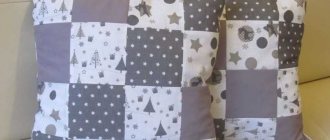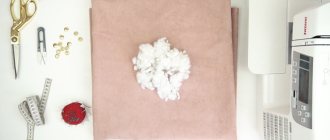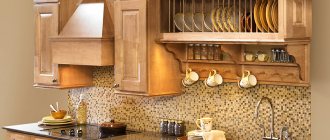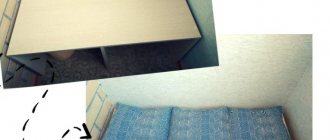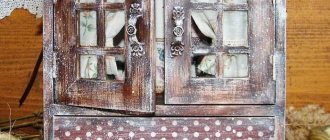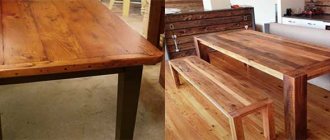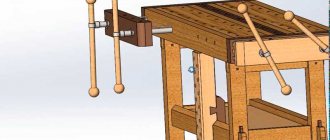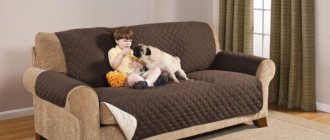Benefits of using a pillow
Chair cushions are useful for absolutely all categories of the population:
- Schoolchildren and students.
- Drivers on long-distance routes.
- Pregnant women.
- Office workers.
- Seamstresses.
There are a lot of options for using this convenient accessory, but the main thing is the practicality of its use.
The use of orthopedic devices promotes blood flow to the pelvic organs and unloads the veins of the lower extremities. As a result, oxygen supply to all muscle groups is improved, lactic acid metabolism is faster, and conditions are created for the prevention of chronic genitourinary diseases.
The positive effect of using a pillow on a pregnant woman’s body deserves special attention. Daily use of a pillow under the back and under the pelvic area significantly reduces the load on the spine and lumbar muscles. And the baby develops in conditions of oxygen supply.
Classification by shape
The shape of the pillow also plays a huge role. It should be chosen in accordance with the expected effect.
Round
One of the most popular options for chair cushions is round, with a hole in the center. It is these models that allow you to create a curve in the lumbar region, which is most comfortable to work with. Additional properties include:
- versatility of use;
- ability to relieve tension in the hip region;
- excellent resistance to heavy weight.
Rectangular
Rectangular-shaped pillows are great for consumers who spend long periods of time sitting.
The advantages include:
- large assortment in terms of sizes;
- ability to reduce fatigue;
- good fixation on the surface of the chair;
- reducing the load on the spine.
Requirements for a homemade pillow
Regardless of the shape, size and type of accessory, a homemade pillow must meet certain requirements:
- Using only high-quality materials for sewing.
- The presence of a removable cover that is resistant to washing and shrinkage.
- No toxic paints when decorating the pillow.
- The fabric used for sewing must have a sufficient degree of porosity.
- No sliding surface.
A big plus will be the presence of orthopedic properties that allow you to increase blood flow to the pelvic organs and relieve congestion in the venous bed of the lower extremities.
Required Tools
To make a pillow you will need:
- Threads. Match the tone of the fabric.
- Set of needles.
- Scissors.
- Roulette or tailor's yardstick.
- Chalk, pencil.
- Sewing machine.
- Jewelry: buttons, ribbons, bows, fringe.
- Pins, stationery clips.
Before starting work, stock up on the necessary tools and materials.
Selection of materials for sewing
Today, the choice of textile fabrics is quite large - natural, synthetic and mixed fibers are available to the modern buyer.
Each of them has a different set of advantages and disadvantages in practice:
Natural fibers. These include linen, cotton, and silk fabrics. They have a rich natural pattern. The fabric is very porous, due to which air circulation is maintained, unpleasant odors do not accumulate and the skin does not sweat.
Note!
- Duvet: TOP-170 photos + video reviews of duvets. Advantages and disadvantages of filler, choice of cover and quilting
- Bed linen for newborns: requirements for bedding for a newborn. Variety of sizes, materials and patterns of children's underwear (photo + video)
Double bed linen: TOP-170 photo reviews of new designs, choice of size, color and material
A significant drawback is the rapid shrinkage of the fabric during washing, as well as fading of colors under the influence of sunlight.
Synthetic fibers. They stand up well to frequent washing and are not subject to color fading for a longer period of time. But the disadvantage of practical use is the low porosity of the structure, due to which the fabric does not allow human skin to breathe.
The best option is fabrics made from combined threads. A small admixture of acrylic increases the material’s resistance to shrinkage and deformation, and the porous structure of natural fibers ensures natural air circulation.
Pros of making it yourself
Hand-made items fully meet the style preferences of the apartment owners. Stools with removable “upholstery” are also practical and protect the surface of kitchen furniture from premature abrasion.
While working on the seat, you can evaluate how suitable the product is in size, which may not happen with a purchased version.
If you sew a cover for a stool with your own hands, it will cost a minimum of money or free of charge when all the materials are at home.
The made seats will look original in the kitchen interior.
The stools will require little fabric and filling, and the appearance of the furniture will change for the better.
The seats, improved by covering, are comfortable and durable. The “upholstery” can be easily removed and washed if necessary.
The seats can be removed to use the stool for household chores without dirtying the fabric.
Types of chair cushions
All pillows differ in a number of properties: shape, size, type and filler used. The following types of pillows are distinguished, depending on their purpose:
Decorative models. They are used only as an addition to the interior. They usually have a rich and stylish design. The quality of the filler and orthopedic properties do not matter.
Orthopedic models. Designed to relieve pelvic blood flow, relieve tension on muscle groups and the spinal column. Minimal attention is paid to decorating the canvas.
Note!
Pillow for pregnant women - TOP 160 photos + video reviews of pillow designs for pregnant women. Properties and purpose of the pillow. Types of fillers and covers- Sofa decks: TOP-130 photos and videos of sofa deck design options for a sofa and armchair. Features of application, choice of color and material of manufacture
Envelope blanket - TOP 150 photos + video reviews of baby envelope blanket designs. Types of safe fabric materials, colors and prints of blankets
Car seat cushions. Intended exclusively for use while driving. They have features of orthopedic and decorative models.
Accessories with an orthopedic component, in turn, are divided into several subtypes. There are sensorimotor, support and wedge-shaped pillows. Each of the presented models differs in the set of functions performed and the advantages of practical choice.
Types of pillow filling
The filler, its quality and basic properties, play an important role in functional terms. Today, any buyer has the opportunity to purchase a variety of types of filler:
Polyurethane. The material is classified according to its degree of rigidity, which allows you to sew pillows with a “shape retention effect.” Polyurethane has a long service life (more than 6 years) and sufficient strength. Great for sewing neck pillows and accessories for the lumbar spine.
Latex is an excellent material for sewing high-quality orthopedic accessories. It is characterized by increased strength, a sufficient degree of porosity and wear resistance.
Polyester. Cheap and high-quality base used to make retaining pillows. Products made from polyester are very light and soft and hold their shape well. A significant disadvantage of use is its short service life.
Note!
Children's blanket: criteria for choosing a blanket for children. A variety of sizes, materials and patterns of children's blankets. Rules for caring for a child’s blanket (photo + video)- Bedspread for a sofa: TOP-140 photos and videos of design options for a bedspread for a sofa. Features of the use of the bedspread, choice of color and material
Wool blanket: options for using wool blankets. Advantages and disadvantages of wool, varieties of sizes and shapes of blankets (photo + video)
When choosing a filler, you should carefully evaluate its basic qualities and properties in order to achieve the desired result in practice.
Textile
When choosing a material, it is advisable to pay attention to wear-resistant, durable fabrics: rep, teak, satin. If the chair is in a cold room, then wear-resistant felt would be an excellent choice. The length of the fabric depends on the size of the chair.
Stylish stripes will add brightness to the interior
It is better to choose the color of the material so that it is in harmony with other interior items - for example, with the colors of curtains, a painting decorating the wall.
Original soft cushions for kitchen chairs
Filler
Furniture foam rubber for filling pillows
Sintepon, holofiber, and foam rubber are suitable for this purpose. The best option is latex. It is resistant to deformation and lasts a very long time.
Tools
Necessary tools for sewing
Fabric scissors (tailor's), sewing machine, thread, needles.
Decorative elements
Beautiful buttons for pillow decoration
Buttons are a universal item. They are sewn on so that the filler does not bunch up into lumps, and at the same time they will decorate the product.
It is better to avoid using rhinestones, beads, and decorative stones when decorating. This is not very practical to use.
Ties
Soft white cover with bow ties
The purpose of the ties is to prevent the pillow from sliding down. Ribbons, laces, ropes, just strips of fabric will help solve this problem.
When all the preparatory work is done, you can get to work. Let's look at the algorithm for the simplest option for sewing a pillow.
Pattern
Pattern for making chair cushions
To make a pattern, you need to determine the shape of the product. The round cushion is more versatile; it will fit any shaped chair or stool. A circle is drawn on a sheet of paper according to the size of the seat, and what we get is cut out.
To make a pattern exactly according to the shape of the chair, it is better to use tracing paper. Place a sheet of tracing paper on the surface of the seat and trace it with a marker. The pattern is ready!
Completing of the work
It is better to make the pattern rigid (from cardboard or plastic)
- Fold the prepared fabric in half.
- Attach the pattern, outline with chalk, leaving 1.5 cm (allowances), cut out.
Materials needed to make a fabric pillow
- Sew three sides of the finished parts. Sew the parts together
- Place filler inside.
- Carefully sew up the remaining edge.
- Sew on the ties. We baste, and then attach the binding to all sides and make ties on both sides
- Decor according to your wishes.
Ready-made soft cushion on a chair seat
This algorithm is used in the manufacture of any type of pillow. Only the material and execution technique changes.
An example of a pillow made from pompoms
Soft seat cushion made of pompoms for a chair
Materials for work:
- knitting threads, preferably thick ones;
- perforated synthetic mesh; the edges of such a mesh do not crumble or spread (it is sold in handicraft stores);
- scissors.
Required tools and materials
Execution steps:
- cut the mesh to fit the seat;
- make the required number of pompoms; Making pompoms of the desired color and size
- tie pompoms to the net;
- We tie each pompom to the net, following the color scheme
- to close the knots on the reverse side, you can use any textile material;
- Ribbons are sewn on at your discretion.
Soft seat made of pompoms of different colors
In this case, you have a choice - to make a classic version with filler or make it as a small rug.
If there is no such mesh, pompoms are sewn to the fabric. It will still be beautiful.
Crazy patchwork technique
Chair seat made using crazy patchwork technique
Necessary materials:
- scraps of fabric in bright colors;
- filler;
- threads, braid to make ties.
Progress:
- make a pattern;
- cut out the shreds - if it is a circle, the shreds look like slices of pizza, if it is a square, then the shreds are rectangular or square;
- cut out a whole part - you get the second side of the pillow;
- sew patches;
- sew two parts of the pillow, fill with foam rubber or holofiber;
- carefully sew up the remaining edge;
- sew strings.
Knitted pillow
Crochet pattern for soft chair cushions
Both knitting needles and a crochet hook are suitable for knitting. If there are leftover threads, then this is the case when they need to be used. It is advisable to knit in a tight knit. Pattern according to your wishes. The corners are decorated with tassels.
Chair cushion “Chess”
Knitted cushions for a chair or stool made of brown melange
Stygis textile applique
Stygis textile is a material treated with hot melt adhesive.
Progress:
- make a sketch of the desired picture;
- transfer it to tracing paper (tracing paper is placed on top of the drawing and outlined with a marker);
- cut out a picture from tracing paper - a stencil;
- using a stencil, cut out a picture from fabric with an adhesive layer;
- attach the cut out picture to the finished pillow, press with an iron (2-3 seconds);
- it is important that the iron is warm; hot will burn through textiles.
Do-it-yourself chair cushions will not only “color” the kitchen or country house with the colors of joy and warmth, but they are also a great gift for friends and acquaintances.
Cushion for a chair or stool “Blue peas”
Video: Chair seat (patchwork)
50 interesting ideas for making chair cushions with your own hands:
We recommend articles on the topic
Types of forged hallway hangers with design options
The hallway is the first thing a person sees when entering a house. When designing it, we often encounter a lack of free space. It’s not always possible to fit a closet or separate shelves for…
Selection of cabinet fronts
Who doesn’t remember a time when pieces of furniture were produced according to a certain pattern? Of course, it’s hard for today’s youth to imagine this. Nowadays furniture is made to suit every taste and color, with an unusual design. Available...
Hanging system for sliding wardrobes: how to choose the right one
Sliding wardrobes gained popularity very quickly and have maintained it for many years. The reason for this was initially the ease of use in small apartments. What is it and how...
How to make a box from postcards with your own hands - instructions
Our grandmothers and mothers found the pleasure of home creativity in making boxes from scrap materials. Moreover, the materials for such crafts are simple, and they are found in every home. And ready...
DIY hanger for the hallway.
When we come home, the first thing we do is take off our outerwear and hang it in the closet or on a hanger. The latter option has some significant advantages: it takes up little space, provides…
How to choose a mattress for a double bed?
Statistics show that 80% of the population of the CIS countries has impaired functioning of the musculoskeletal system. Data shows that the disorders occur in schoolchildren, so it is believed that the main cause is...
Choosing a pillow shape
The shape of the product also has practical significance. For example, some models can be conveniently combined with chairs in the dining room or modeled to fit the size of a car seat. The following standard forms for accessories are distinguished:
- Rounded model. A cushion for a round chair is the best option for DIY sewing.
- Square model. Very often it is equipped with side latches, which allows you to take the accessory with you on a trip.
- Cylindrical pillow models. Most often used as retaining orthopedic products (for the cervical or lumbar spine).
There are also wedge-shaped and cushion-shaped pillows, but they are more specialized and are used for patients with injuries and disorders of the musculoskeletal system.
What are orthopedic products used for?
This type of orthopedic products is used for various purposes:
- To organize a work area where it is comfortable to sit;
- For use while traveling by car;
- For people with limited mobility;
- For pregnant women.
Look at the photo of the chair cushion: models with an unusual design can take their rightful place in the interior. And for health, these products can only bring benefits.
Sewing a pillow with your own hands
Absolutely any housewife has the opportunity to sew a chair cushion with her own hands. To work, you need minimal needlework skills and tools (threads, needles, ready-made patterns or a set of patterns). The sewing process consists of several stages:
- Preparing a pattern for sewing a chair cushion. Without the skills of making patterns, you can use ready-made layouts for novice craftsmen.
- Preparation of main parts.
- Assembling parts into a single product and stuffing with filler.
The work is completed by sewing a decorative and protective cover. Beginning needlewomen can watch a master class on sewing a chair cushion to make the task easier.
Mounting options
To prevent a hand-made seat from sliding onto a chair, it must be secured. There are several fixation options.
- For square stools, it is enough to sew 4 small elastic bands at the corners to the pillow.
- The round one is fixed with an elastic band around the perimeter, for which a drawstring is sewn to the product.
- You can attach a seat to a chair with a back if you attach 2 ties in the corners and connect them with a knot under the seat. They are usually made from the same material as the fabric of the cover.
- The simplest method of fixation is fastening using ordinary Velcro, which is attached to the edges of the pillow.
All fastening options are selected taking into account the type of finished product.
With strings
Using an elastic band around the perimeter
Velcro
Sewing a decorative cover
The cover for the chair cushion must be removable so that the housewife can wash the cover if it gets dirty. In practice, they try to use combined types of textiles for sewing covers that meet all safety and practicality requirements.
Working on creating a convenient accessory is not as difficult as it seems at first glance. Craftsmen will benefit from detailed instructions on how to make a chair cushion.
What do we need
To sew a chair cushion with your own hands you will need:
- textile;
- filler;
- rubber;
- buttons;
- tailor's scissors (especially for fabric);
- wire cutters for cutting threads;
- sewing machine;
- measuring tape;
- pins;
- marker, pencil or fabric chalk.
Materials for the pillow
To sew a product that will last a long time, choose durable fabrics, for example, satin, flock, cotton, rep. For chairs that will be located outdoors or in a cold room, wear-resistant felt is suitable. You need to prepare the fabric so that it is slightly larger than the size of the chair seat. But we will determine this later.
Choose the color of the fabric so that it matches the design of the room. If the pillow should serve for convenience and not attract attention, choose calm, monochromatic shades.
But often removable pillows on stools are used to dilute the interior and add zest to it. In this case, choose the color and material carefully.
Fabric with an unusual pattern or bright colors will do, it just depends on your taste.
Don't forget to find threads that match the fabric of your choice.
There are various fillings for chair cushions, the following are usually used:
- Sintepon. The material is hygroscopic and hypoallergenic.
- Holofiber. This is a hypoallergenic, wear-resistant material that does not absorb odors and has thermoregulating properties.
- Latex. Durable and deformation-resistant material. For stuffing pillows, so-called latex crumbs are used.
More decorative elements will be needed. But it is better to avoid rhinestones, beads and stones, as they are impractical when using a seat. You can sew buttons onto the product. They will not only decorate the product, but will also prevent the filler from forming lumps. Prepare the most ordinary buttons, because they will need to be covered with fabric, and there is no point in expensive and beautiful ones.
Pattern
Making a pattern is very simple. To calculate the size of the fabric, measure the diameter of the chair for which you are going to sew a pillow.
When you fill it, the size will decrease slightly, so the material needs to be calculated with a margin. For the volume of the product you need to add 2.5 cm on each side of the diameter of the chair.
Thus, if the diameter of the stool is 35 cm, add 5 cm to it, it turns out that you need a square of fabric with sides of 40 cm.
Fold the cut square in half, and then in half again. In our case, the length of the sides of the folded square is 20 cm. You should also get a side length equal to half the diameter.
Now take a measuring tape and a marker (or pencil, chalk). Your radius will need to be laid out over the entire quarter of the square (for us it is 20 cm). Measure the length of your radius on the tape and attach it to the lower right corner of the fabric diagonally to the left, make a mark.
That is, the diagonal from the mark to the lower right corner should be equal to your radius. Then turn the measuring tape to the sides, like a compass, and make several more such marks throughout the quarter.
Connect the marks into a single line, a quarter circle should form.
Take scissors and cut the fabric along the resulting line. Cut the material, you should get an even circle. Do the same with another piece of fabric, since for one pad we need two identical circles.
Sewing process
The pillow needs something to hold it on the chair. An ordinary rubber band will help us with this. Its length should be equal to the diameter of the stool, in our case - 35 cm. Take one of the previously cut circles of fabric and attach an elastic band to its edge, secure it with a pin. We do this on the front part of the material. Pull the elastic a little and secure it on the opposite side.
Place the second circle face down. Connect the two circles with pins. Then they need to be stitched, but leave a 10 cm hole. This is needed so that the product can be stuffed with filler.
Operate your sewing machine slowly so that if wrinkles appear, you can smooth them out. Then you will get an even line.
Turn the pillow inside out and straighten it out. On one side we have an elastic band, on the other we will sew buttons. Fill the product with filler through the hole left. Distribute it well inside. If you need a voluminous seat, then fill it more tightly. But for chairs, as a rule, flat versions are made.
Now you need to sew up the hole. Tuck the seam allowances inward and secure with a pin. Next, you can sew the stitch on a sewing machine or sew it by hand. The last option will be more accurate.
Take a needle and thread that matches the color. Insert the needle from the edge of the hole so that you can hide the knot inside. Next, move like a snake: first grab 1-2 mm from one side of the fabric, and then from the other. Once the hole is sewn shut, remove the pin and distribute the filler evenly once again.
The handmade pillow is ready. All that remains is to sew on the buttons.
Buttons
Choose the number of buttons yourself. It could be one large one in the center or three or four small buttons.
The buttons need to be trimmed: this way they will look more beautiful and become comfortable when using the pillow. Let's look at the simplest way to do this:
- Cut a circle from the fabric whose diameter is 2 times larger than the button.
- Take a thread and a needle and place a circle over the button. Insert the needle from the wrong side of the fabric (you need to step back 1–2 mm from the edge).
- Grab the opposite edge of the fabric from the front side. The button should be inside.
- Do the same with the remaining two sides.
- Now you need to connect the formed corners. Hook them with a needle along the edges on opposite sides and sew.
- The button for the pillow is ready. Sew the rest of the buttons in the same way.
On the pillow, mark with a marker the points where the finished buttons will be sewn. Distribute them so that they are an equal distance from the edge and from each other. Take your thread and needle again and push it through the inside of the button.
Next, in the marked place, pierce the pillow right through with a needle. From the reverse side, bring the needle back to the front part and tighten the thread so that the button goes inside and creates a beautiful volume.
Then pick up the button and again bring the needle to the back of the pillow, tie a neat knot there. Do the same with the other buttons.
Now is the time to try on the finished pillow. To ensure that the product holds well, hook the elastic band through the two legs of the stool.
This work will not take much time, but you will make the chairs soft, comfortable and beautiful with your own hands.
Source: https://bespoked.ru/blog/sshit-krugluyu-podushku-na-stul/
